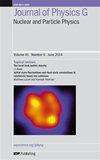Daily and annual modulation rate of low mass dark matter in silicon detectors
IF 3.5
3区 物理与天体物理
Q2 PHYSICS, NUCLEAR
Journal of Physics G: Nuclear and Particle Physics
Pub Date : 2024-01-22
DOI:10.1088/1361-6471/ad1a76
引用次数: 0
Abstract
Low-threshold solid-state detectors with single electron excitation sensitivity can probe nuclear recoil energies in the sub-100 eV range, coinciding with the typical threshold displacement energies in the detector material. We investigate the daily and annual modulation of the observable event rate for dark matter mass ranging from 0.2 to 5 GeV/c2 in a silicon detector, considering the energy threshold and the direction of the nuclear recoil. The data for the energy threshold is obtained from a molecular dynamics simulation. It is shown that the directional dependence of the threshold energy and the motion of the laboratory result in the modulation of the interaction event rate. We demonstrate silicon’s average annual interaction rate is more considerable than germanium for low-mass dark matter. However, their event rates take a similar trend in large dark matter masses. Thus, silicon can be a reliable target to discriminate low-mass dark matter from backgrounds. We also find 8 h and 12h periodicities in the time series of event rates for silicon detectors due to the 45-degree symmetry in the silicon crystal structure.硅探测器中低质量暗物质的日调制率和年调制率
具有单电子激发灵敏度的低阈值固态探测器可以探测 100 eV 以下范围的核反冲能量,这与探测器材料中典型的阈值位移能量相吻合。考虑到能量阈值和核反冲的方向,我们研究了硅探测器中暗物质质量从 0.2 到 5 GeV/c2 的可观测事件率的日调制和年调制。能量阈值的数据来自分子动力学模拟。结果表明,阈值能量的方向依赖性和实验室的运动导致了相互作用事件率的调制。我们证明,对于低质量暗物质来说,硅的年均相互作用率比锗更可观。然而,在暗物质质量较大的情况下,它们的事件发生率趋势相似。因此,硅可以作为从背景中区分低质量暗物质的可靠目标。我们还发现,由于硅晶体结构的 45 度对称性,硅探测器的事件率时间序列存在 8 小时和 12 小时的周期性。
本文章由计算机程序翻译,如有差异,请以英文原文为准。
求助全文
约1分钟内获得全文
求助全文
来源期刊
CiteScore
7.60
自引率
5.70%
发文量
105
审稿时长
1 months
期刊介绍:
Journal of Physics G: Nuclear and Particle Physics (JPhysG) publishes articles on theoretical and experimental topics in all areas of nuclear and particle physics, including nuclear and particle astrophysics. The journal welcomes submissions from any interface area between these fields.
All aspects of fundamental nuclear physics research, including:
nuclear forces and few-body systems;
nuclear structure and nuclear reactions;
rare decays and fundamental symmetries;
hadronic physics, lattice QCD;
heavy-ion physics;
hot and dense matter, QCD phase diagram.
All aspects of elementary particle physics research, including:
high-energy particle physics;
neutrino physics;
phenomenology and theory;
beyond standard model physics;
electroweak interactions;
fundamental symmetries.
All aspects of nuclear and particle astrophysics including:
nuclear physics of stars and stellar explosions;
nucleosynthesis;
nuclear equation of state;
astrophysical neutrino physics;
cosmic rays;
dark matter.
JPhysG publishes a variety of article types for the community. As well as high-quality research papers, this includes our prestigious topical review series, focus issues, and the rapid publication of letters.

 求助内容:
求助内容: 应助结果提醒方式:
应助结果提醒方式:


